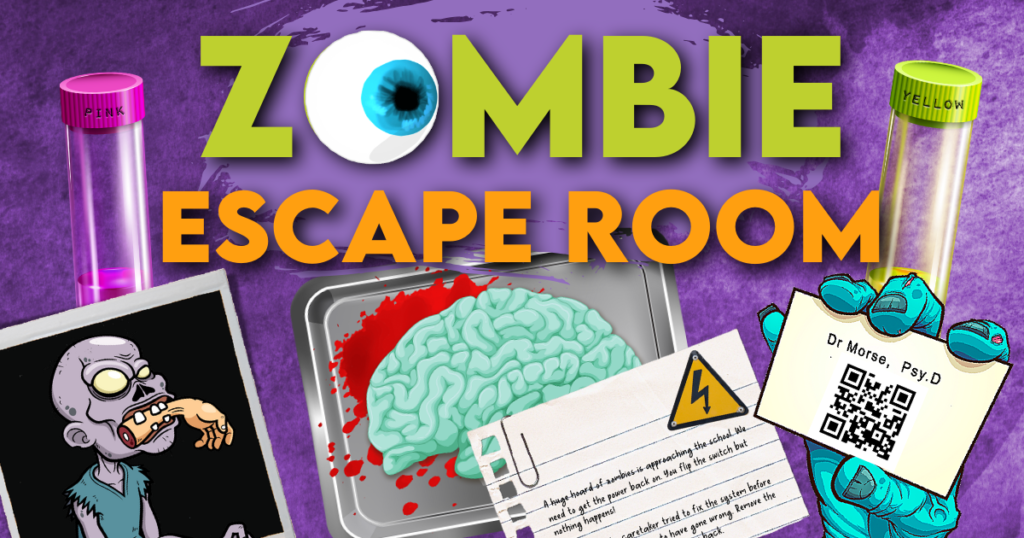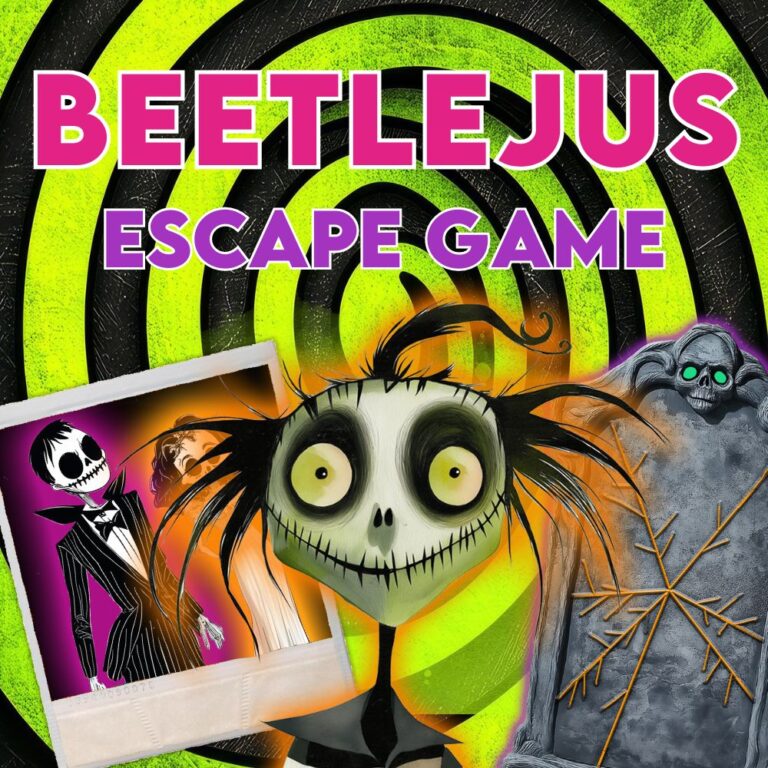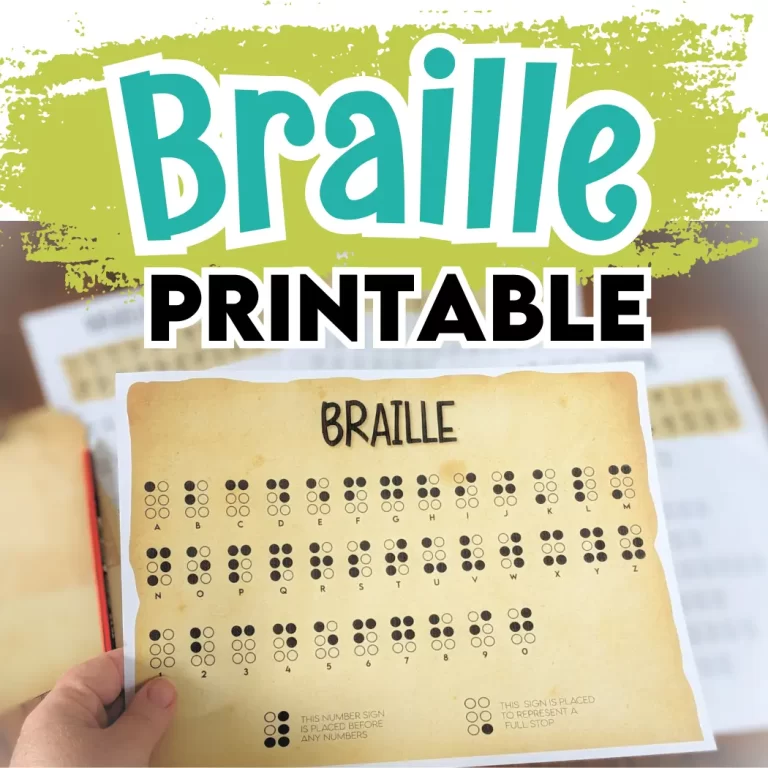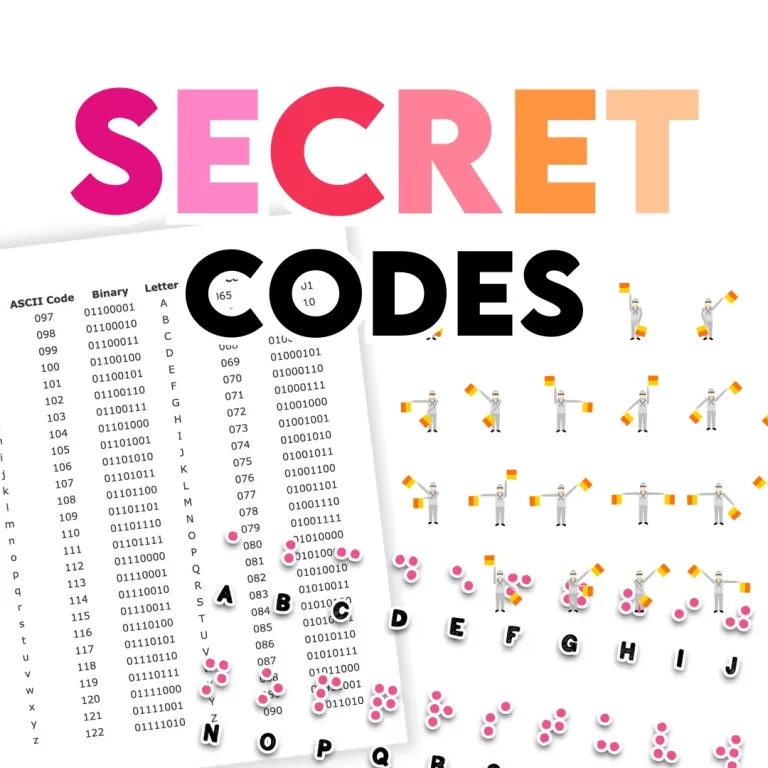Easy DIY Escape Room Puzzle Ideas You Can Use Today!
This post may contain affiliate links, please read our affiliate disclosure.
Are you excited about the idea of hosting your own escape room at home? Searching for creative DIY escape room ideas? While planning the perfect escape room experience might seem a tad daunting, I’m here to share some puzzle ideas that will kickstart your journey in no time.
Planning the perfect escape room game is a balancing act. Nobody wants to be faced with 10 complex math problems to solve or just a bunch of QR codes to scan. Getting a good mix of puzzles with varying difficulty is key. So, if you’re ready for the challenge, read on. You’re in the right place to discover some fun DIY escape room ideas.
HOW TO CREATE AN ESCAPE ROOM
So, my first tip is to KEEP IT SIMPLE. Puzzles don’t need to be hard to be fun. You can easily increase a puzzle’s playability by hiding elements around the room. The ultimate goal is to make your job as the game master as easy as possible. In my early days, I spent far too many late nights planning super crazy escape room puzzles and going totally overboard with my theme. I thought it was a good idea to make my own escape room, just like the commercial escape rooms. The important thing I learnt was simplicity is key!

Choose your Escape Room Theme
If you are planning your first DIY escape room, this part is super fun. Top tip: Don’t spend too much time pondering your escape room theme. The theme is just the starting point; the important part of the game is the various puzzles and challenges you create.
Here are a few theme ideas to get you going. These ideas should all be easy to find information on when planning your puzzles later.
- A Movie Escape Room Theme- think Indiana Jones, Marvel films, or any favorites.
- Book series – Harry Potter or Hunger Games are great themes.
- Favorite TV shows.
- A board game – How about Monopoly or Cluedo (Clue for my friends over the pond).
- A historical event – The great train robbery or the discovery of Tutankhamun, for example.
Escape Room Mood Board
When I start planning my escape games, I like to create a mood board. I find this really helpful when planning my DIY puzzles. Grab a piece of paper and jot down your ideas. I know it’s not everyone’s cup of tea, but I find it really useful, especially if I have lots of ideas.
DIY Escape Room Ideas!
Let’s start planning your escape room challenges and get ready to throw in a secret message or two.
1. Jigsaw puzzles:
Don’t underestimate the humble jigsaw puzzle. Everyone knows how to use them, which is a bonus, and you can easily adapt them to reveal different pieces of information.

How to use jigsaw puzzles in your escape room game.
- Use your own images to create your jigsaw puzzle. The images can lead to objects or items players need to discover.
- Write your clue on top of a dollar store jigsaw puzzle (front or back will work).
- Use Black light will reveal a hidden message written on the puzzle.
- The picture you use for the puzzle could be a QR code for players to scan.
- Write a number on the reverse to reveal the digits to open a number lock.
Top Tip
You can make a puzzle more challenging just by adding extra steps to solve it. You do not need to make the puzzles overly difficult to be fun. A simple and effective way to do this is to use a secret code or cipher instead of plain English. Or by sending players to another area to find an additional piece of information to help them solve the clue.
2. Candy Lock Code Escape Room Puzzle
One of my favorite clues to reveal a lock combination is using candy. The correct answer is discovered by sorting and counting different colored candies into the right order. This series of puzzles is great for younger players. There are all kinds of other objects you could have players sort. Cutlery, lego bricks, crayons, how about sorting hidden treasure for a pirate-themed escape room?
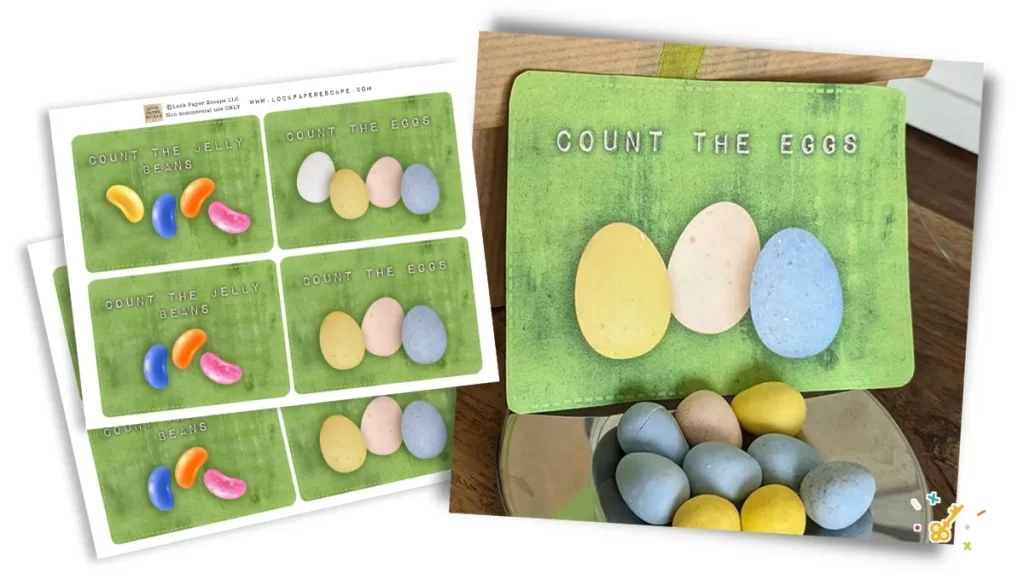
I used the candy lock code puzzle in an Easter themed escape room game I created for my kids and used Cadbury mini eggs.
3. Grille Cipher Escape Room Puzzle
I love the simplicity of using grille ciphers in my escape rooms. They are a great way to reveal information hidden in plain sight. The grille or overlay is placed over a piece of text or image. Holes in the grille reveal information players need. Here are a few ideas for incorporating the grille cipher into your own DIY escape room. This type of cipher is a great puzzle for young children. You can easily increase the difficulty level by having the text discovered written in a secret code.
- Placed on top of a letter, the players discover a hidden message.
- Overlaid on top of a specific page in a book will reveal information players need.
- Use to place over a photograph to highlight details the players need to know.
- Use it to place over a poster of the alphabet. Players unscramble the letters to reveal a word.
- Place the grille on top of a map to reveal the location of the next clue.
4. Blacklight and Invisible Ink
Imagine uncovering hidden secrets with the flick of a switch! Incorporating blacklight or invisible ink into your DIY escape room adds an extra layer of excitement. Picture your players discovering a seemingly unimportant piece of paper, only to reveal crucial clues under the glow of a blacklight. Whether it’s secret messages, hidden maps, or concealed codes, using invisible ink and blacklight is a fab addition to your game.
5. Balloon Pop Puzzle
I have used balloons as hiding places for clues in my escape games a lot! I have used them to conceal keys, hide word puzzles and even jigsaw pieces. They can also be used just like in the candy puzzle and counted and sorted to reveal a numerical answers. TOP TIP: If you are planning on using them, check to see if players have allergies to latex or have a balloon phobia! The last thing you want is a bunch of terrified players!
6. Word Lock
These are fun locks to use. You are limited by the letters on available on the word lock, I have a few and they are all different. So you may have to adapt your clues to match the words you can make. Throw in a lock or two into your escape room game. You can and a lock to all kinds of things.
- Lock up an entire room.
- Lock away the contents of a box or container.
- Lock shut a pair of scissors.
- Lock up a drawer, or cupboard that contains a clue.
- A filing cabinet.
- Lock up a zipped bag.
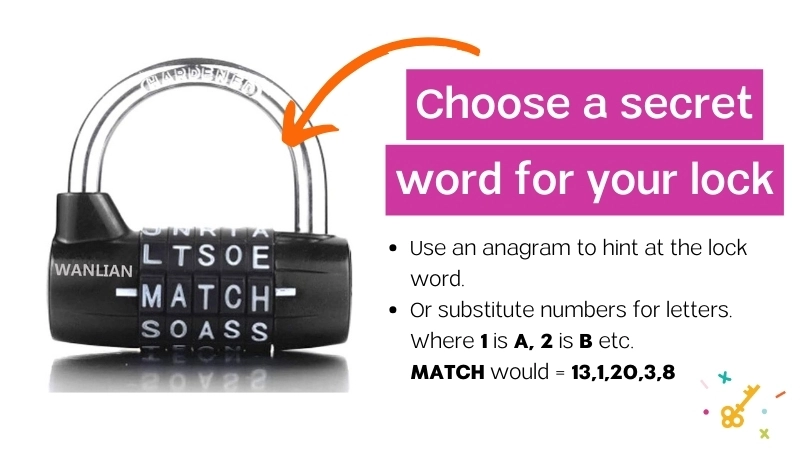
Here are different ways you can reveal a clue to open the word lock in your DIY escape room.
- Attach a tag to the lock or your locked box with the word to open it. But use Morse code or another code or cipher.
- Substitute the letters in your word for numbers.
- Have a picture in your escape room of whatever the word is. For example, your word is EAGLE. Place a picture of an Eagle into a picture frame, plus add a little image of a lock or the word lock written on it somewhere (you could also use UV).
- Use the image of the Eagle but this time cut it up to make a jigsaw puzzle.
7. Audio Push Buttons
These are a lot of fun to use. I purchased a set from Amazon. The buttons are intended for training dogs, but they are perfect for escape room puzzles. Each button is a different colour and programable to add your own audio. You can record messages, single words, add a song, or even play Morse code dits and dahs.
8. Number Combination Lock
You probably have one of these types of locks lying around your house. The beauty of using a number combination lock is the puzzle possibilities. Anything that has a digit on it can be used as a clue.
- The numbers on a clock or watch face.
- Roman numerals.
- A takeaway menu or recipe
- Phone numbers.
- Maths problems.
Let’s delve into a practical example of using a takeaway menu to reveal a four-digit lock code. First, you’ll need a menu. Use one you already have, or create your own. To indicate your clue, you can either circle the menu items (remember to include the order somehow) or jot down the name of each dish in the order you need on a piece of paper, just as if you were getting ready to place an order over the phone. It’s a simple yet engaging way to crack a fun little number code.
9. The simple art of hiding stuff!
Yep, just hiding things around the room is simple and effective. Under rugs, inside books, behind a picture frame or door.
10. Measuring Objects
There are all kinds of ways that you can measure different objects. Use a ruler or tape measure, weigh something, or measure the amount of liquid something holds. Use the numbers to reveal information players need. The numbers can be used for codes or translated into letters to reveal a secret message. Regular tasks like this are fun as the players must do something physical to reveal the final solution.
11. Colored Words
A very simple and effective way to reveal information to players is to hide your information in plain sight. This simple idea has players reading only words or letters that are written in a certain color. To use this type of puzzle, create a letter or write a postcard that can easily be incorporated into your game theme. Change the color of only the words you wish to use in your message. To make this puzzle slightly more difficult, have words highlighted using different colors. Only one color reveals the correct message. The players must use problem-solving skills to decipher which is the correct color.
12. Popsicle Stick Code
There are lots of different ways to reveal information to players. I have used all kinds of objects to write clues on. Stacking popsicle sticks with a word or code written on the side in permanent marker is a fun revel. The popsicle sticks need to be stacked in a certain order to reveal the word. Here are a few ideas you can use to sort and order the sticks.
- Order by the correct order of the colors in the rainbow (paint your sticks to match).
- Order by numbers, 0-10 or prime numbers, odds or evens will all work
- Order by letters in the alphabet
- Use a codeword with letters written on each popsicle stick.
- Use a digit code to order the popsicle sticks correctly.
Secret Codes & Ciphers
There are so many different types of codes and ciphers. If you are feeling adventurous, you can even make up your own. Using secret codes is an easy way to conceal a message, but it requires some effort on the part of the players to find the real meaning. Messages can lead players to hidden objects or give instructions on how to solve a particular clue.
13. Morse code
Incorporating Morse code is pretty easy! Write out your messages in the code using dots and dashes or be more creative using sounds or lights being flashed. I will add a note to say that I have found there to be an equal measure of love and hate around the use of solving Morse code using sound. Players either really love the challenge or despise it! I tend to stick to using visual Morse code clues. If you have ever watched “Task Master,” in one of the episodes, they used balloons to reveal a message written in Morse code, just genius! I have a Morse code activity pack available for free in my shop.
14. PigPen Cipher
I love using the pigpen cipher. It looks so abstract but is super simple to solve. Using the cipher is a fun and easy way to add a coded message to your escape room. Here’s how it works: Letters are placed inside a grid. The shape of the grid around the letter is shown as the cipher.

This simple substitution makes your secret messages look like ancient secret code or new language, adding a fun challenge for your players to solve!
GRAB A FREE ESCAPE GAME
Grab yourself this Printable Kids Birthday Escape Room Game 100% FREE! All you have to do is subscribe to my creative escapes newsletter, and the game will be sent right to your inbox.
Finalise your escape room puzzles
You now have a good amount of puzzles. Time to think about the order of things. Are some of your clues going to be hidden? Keep a note of where you are going to hide clues. Can players progress with the game while still figuring out how to open a locked box?
The simplest way to figure this out is to draw a really simple flow chart with where the puzzles will be and what elements are need to solve each puzzle. If you are new to making games keep this as simple as possible don’t hide lots of elements to solve a puzzle in lots of different locked boxes with ciphers and riddles.
Time to do a test run. Something really simple may have been overlooked. Now is the time to iron out all those kinks. Make sure any printables have printed correctly and that all your locks work. You can always remove and add puzzles if you feel it needs more or less.
Prep and play your game.
Now, you should have a good idea of how to set up your own escape room game, but if you want to take out some of the hard work, you can take a look at our kits. Our printable packs include lots of puzzles for a fun party-style game. Use them as a starting point, add physical locks, and go all out with the themeing for a really fun at-home game.
Let’s stay connected!
Love this? Make sure to connect on your favorite social platform below for even more fun and games!
Zombie Escape Room
The zombies are on the loose. Will Dr Pepper become a zombie, and will you survive long enough to save the world? Do you have what it takes to find a way to escape before the zombies get you? Try our fab family Zombie escape game!
